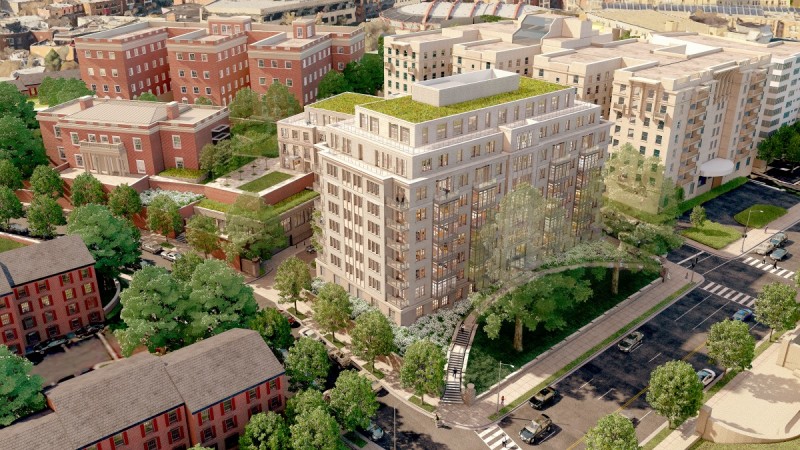DC’s historic preservation board approves a building on 16th Street without saying “take off a floor”

The proposal for 2300 16th Street, NW. All images from Perkins Eastman used with permission.
“Just take off a floor” was a far too common refrain from DC's Historic Preservation Review Board in recent years. For a proposed condo building on 16th Street NW near Meridian Hill/Malcolm X Park, the board decided a shorter building would actually be less historically compatible.
In many recent HPRB cases, one member, Hartman-Cox Architects partner Graham Davidson, almost invariably judged any building as “too tall.” Neighbors would complain most loudly about a project's height. And the board would seek to find some kind of compromise ground by asking property owners to make their buildings a little shorter.
Shorter doesn't always mean better
This was, in many ways, the worst of the options. Shorter buildings can look squat and less interesting than what passes for “tall” in DC (hint: not tall). Opportunities to create much-needed housing, including affordable housing, are lost for decades. And by relentlessly focusing on height, it pushed architects to make the buildings as wide and blocky as possible to get square footage into a shorter space.
As with, for instance, the SunTrust plaza in Adams Morgan, it's possible a taller building could leave more public plaza space around it, or otherwise meet other neighborhood needs. Thanks to what I call “height-itis,” though, local Advisory Neighborhood Commissions tend to obsess only about the number of feet from the top to bottom of a building instead of its street appearance, where details can matter a lot. And thus, often so did HPRB.
A photo of the site, March 2017. 
HPRB debates design quality instead of height
Is that changing? The board has occasionally decided that shortening a building diminishes its overall architectural merit. Last month, it did so again with a proposed development on 16th Street NW in DC, across from Meridian Hill/Malcolm X Park. There, the Meridian International Center operates out of a historic mansion along Crescent Place; the 16th Street side of the property is just a vegetated hill and a sign.
The organization is selling that part of the property to developer Westbrook Partners to raise funds for the center. Adams Morgan's ANC 1C has opposed everything, even after Westbrook shrank the building, losing 30 potential homes, in response to ANC complaints.
HPRB did agree in December 2016 with arguments that the initial design was too tall, so architects Perkins Eastman lowered the berm around the building, set back the top floors, and shaved corners using balconies:
The proposal as of December 2016 (option B). 
The approved proposal (option C). 
ANC 1C still urged HPRB to reject the whole thing, but if not that, take off a floor. HPRB asked the architects to envision what such a truncated building would look like. Perkins Eastman designed two options:
Option D, with one floor removed and no corner balconies. 
Option E, with one floor removed from C. 
It's not an improvement, the board ultimately judged at its June 29 meeting. Davidson is no longer on the board, and seven of the nine members chose to move ahead with C. Two, chair Marnique Heath and Joseph Taylor, wanted the shorter D.
The official HPRB action says, “The Board considered and gave great weight to the resolution of the ANC asking the Board to deny the proposal or alternatively to approve option E, but found that option C more successfully responded to the previous direction and findings of the Board and that option E had incompatible proportions for a building of this type in the historic district.”
Preservation staff were not fans of E at all, writing that “E has an insufficient and classically ill-proportioned midsection that is too small to support the two upper floors; the reduction in the height of the bays and the corner balconies further compound the problem and results in a design that is incompatible with the Meridian Hill Historic District.”
These statements are significant, because both staff and the board are arguing that shorter buildings might be less “compatible” than larger ones. (Compatibility is the standard for judging new construction in historic districts or as part of landmarks). The Davidsonian view is that smaller is always more compatible, but he forgets that we live in a city.
Plus, most preservationists believe new buildings should be “of their time”—not faux-historic but readily identifiable as being a 2017-era building. If buildings' materials don't need to match the surroundings, but should be current, why not the height, too? Besides, 16th Street is already full of large apartment buildings. Arguably, the large apartment building look is most compatible with 16th Street, and the board seems to agree.
Might this herald a new era where the board still pushes for architectural merit, quality materials, and interesting details at pedestrian scale, but is less obsessed with height (and even views height as sometimes a boon to compatibility)? Let's hope!
